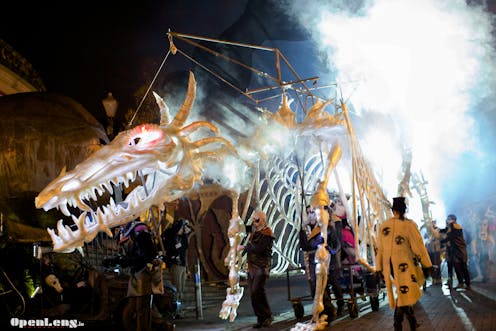A dragon-led recovery: how a community is reaping the benefits of a spooky Halloween festival
- Written by Tony Matthews, Lecturer in Urban and Environmental Planning, Griffith University

In just over a decade, the Dragon of Shandon has become one of Ireland’s largest and best-known Halloween festivals.
The annual event, led by Cork Community Artlink (CCAL), is a creative partnership between artists and local communities. Staged in Shandon in the city of Cork, the festival takes advantage of the atmospheric backdrop provided by the inner-city neighbourhood’s heritage buildings and streets.
The event centrepiece is a ten-metre-long dragon, which stalks Shandon’s streets accompanied by a cast of ghosts and ghouls drawn from surrounding communities and celebrating local myths, legends and history.
Festivals like the Dragon of Shandon are becoming more prominent features of cultural landscapes around the world. Ranging from small street fairs to extravagant spectacles in city centres, urban festivals can generate positive returns for entire cities and local urban areas.
Highlights of the 2016 Dragon of Shandon.The benefits of urban festivals
Museums, stadiums and other “concrete culture” have traditionally enjoyed priority in urban cultural development.
However, this infrastructure is expensive to build and maintain, and is often underused. In response, cities are increasingly favouring festivals as a less expensive and more organic way to engage and entertain urban communities.
Further reading: Why cities should stop building museums and focus on festivals
The scale and focus of film and music festivals can vary from being locally focused to being internationally significant.
Mixed media festivals, like the Edinburgh Fringe, often cater to an international audience. Likewise, festivals of food and drink, pop culture and high culture are continuing to grow in popularity as they capture distinctive local and national audiences.
What connects these types of festivals is that they are often exclusive in nature. Festival-goers generally pay to attend the whole festival or individual events.
By contrast, urban festivals based on occasions like Halloween are typically more open, inclusive and accessible to a wider community. Including community members as spectators, parade participants and event co-creators is central to the success of the Dragon of Shandon.
A celebration of community
Urban festivals like the Dragon of Shandon can activate underused or dead places, by inviting local communities to reimagine how they can use these spaces. In drawing on existing public and cultural assets, these festivals can also invigorate local pride and sense of place and belonging.
CCAL artistic director William Frode de la Foret says:
A carnival should should not be about commercial or even artistic interests; at its heart it should be about the people and the community they live in and it should be fun.
The focus on democratising art production and including local communities is a priority for CCAL. The same ethos of community involvement underpinned the Big Wash Up outdoor murals project, also in Shandon.
Further reading: How murals helped turn a declining community around
The Dragon of Shandon was designed to be an inclusive and family-friendly event to celebrate the Irish tradition of Samhain (Halloween). Halloween in Ireland was traditionally a community event centred on activities like bonfires, games like apple-bobbing, eating bairín breac (Halloween cake), and trick or treating. The Dragon of Shandon has reinvigorated this communal focus in Cork.
The elaborate spectacle relies on extensive community involvement in planning, logistics, event management, crowd control and parade participation.
Volunteers work with CCAL for months to build detailed floats and puppets. Other volunteers spend countless hours learning intricate choreography or perfecting atmospheric musical performances to heighten the affective impact of the parade.
Children and young people take part in designing and creating new props, masks and costumes each year. Many of them also join the parade cast, leading the dragon through the streets of Shandon.
Local children take part in Dragon of Shandon workshops.Feeding the dragon
The Dragon of Shandon has grown in scope, ambition and popularity since it began in 2006. Last year’s event was the largest to date with more than 500 participants and 15,000 spectators. Led by CCAL, the work and dedication of local volunteers have achieved this on a meagre budget.
Some might wonder if it’s worth investing so much time and effort in a local event that lasts one night.
While the spectacle might provide only a night’s entertainment, the months of planning and creativity that make the festival a reality create a sense of community that arguably lasts much longer. The benefits extend to the city of Cork, which can showcase its local heritage and civic pride.
To date the Dragon of Shandon has relied on community support and donations from a small number of corporate sponsors. An interesting question is whether increased external funding would benefit the Dragon of Shandon. Or would this potentially dilute its culture of community involvement and creativity on a limited budget?
Dragon of Shandon Parade fundraising video.Authors: Tony Matthews, Lecturer in Urban and Environmental Planning, Griffith University



